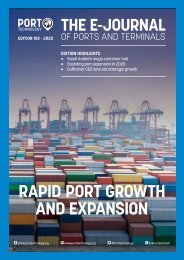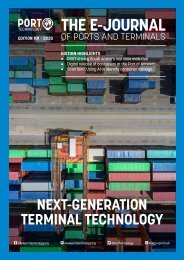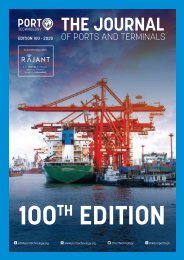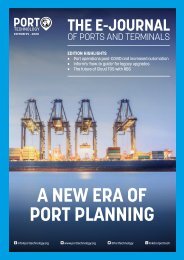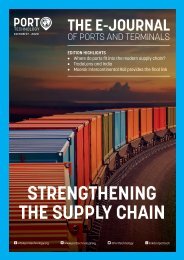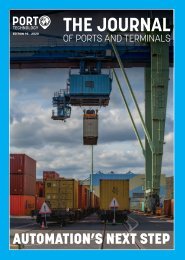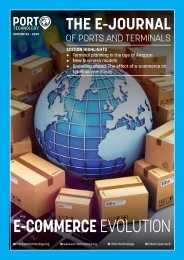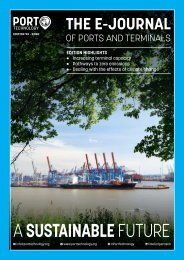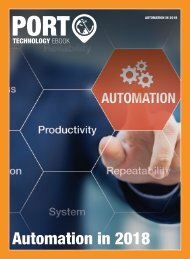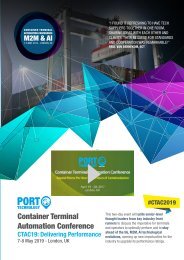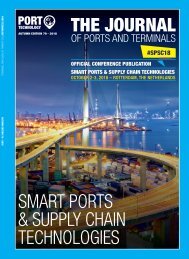Automation Innovations
As we enter the second half of 2020 the full effects of the COVID-19 pandemic are now being realised across the global economy and the port industry. For many, cargo throughput has been significantly decreasing compared with the same period for 2019. For example, the Port of Los Angeles handled 581,665 TEUs in May, a 29.8
As we enter the second half of 2020 the full effects of the COVID-19 pandemic are now being realised across the global economy and the port industry. For many, cargo throughput has been significantly decreasing compared with the same period for 2019.
For example, the Port of Los Angeles handled 581,665 TEUs in May, a 29.8
Create successful ePaper yourself
Turn your PDF publications into a flip-book with our unique Google optimized e-Paper software.
Q&A WITH<br />
KALMAR AUTOMATION SOLUTIONS<br />
cope with it, as the project delivery team<br />
might have been too disconnected from<br />
the operations team. Consequently, the<br />
project team is the only one that can keep<br />
the system running. This escalates when<br />
operations are carried out continuously in<br />
consecutive shifts with different people.<br />
Additionally, the system might not align<br />
completely with the local processes and<br />
operating environment. New procedures<br />
are forced to roll out in fast-paced environments,<br />
causing unplanned system and procedure<br />
changes along with all the subsequent<br />
implementation struggles that come<br />
with them. As terminals are real nexuses<br />
of information, it is very likely that these<br />
changes also impact external parties like<br />
shipping lines and their agents.<br />
The quality of the data can cause issues<br />
when the data is processed automatically<br />
without human intervention. An inaccurate<br />
piece of data that in manual operation was<br />
meaningless, suddenly may become the<br />
root cause of a serious productivity issue.<br />
Many terminals have adopted a ‘mix-andmatch’<br />
principle in automating their operations<br />
by using the suppliers considered as<br />
‘the best of breed‘ for each individual subsystem.<br />
Unfortunately, this compromises<br />
the usability of the system for the end user.<br />
Diagnosing and resolving faults in this kind<br />
of mixed environment is very complex, especially<br />
when multiple user interfaces need<br />
to be cross-checked, often requiring manual<br />
intervention. The exceptions will not be<br />
noticed before they escalate on a terminal<br />
level, and have a serious impact on productivity.<br />
The long-term reasons for not meeting<br />
targets might be being locked in the implementation<br />
mode, waiting for suppliers<br />
to complete the punch list items. While<br />
issues are being resolved, new things are<br />
identified, causing a never-ending project.<br />
To overcome this, it is essential to agree<br />
on how the project will move from implementation<br />
to operational mode, and reach<br />
an understanding with suppliers to provide<br />
support in the continuous development activities.<br />
It is important to understand that automation<br />
systems should operate at least for<br />
as long as the lifetime of the equipment.<br />
When equipment is purchased in several<br />
batches, the system is expected to exist<br />
longer than the equipment itself, i.e. the<br />
equipment can be renewed, while the automation<br />
system continues operating. Therefore,<br />
it is essential that software can be<br />
maintained and upgraded, as the environment<br />
around it changes. New operating systems<br />
and IT solutions are introduced, parts<br />
are reaching their end of lifetimes, operating<br />
processes and regulations change, and<br />
the system needs to be able to cope with<br />
many of such changes during its existence.<br />
Very often this is not considered in the procurement<br />
phase, where the focus is just on<br />
the go-live, and later it comes as a surprise.<br />
WHAT ARE THE CONSEQUENCES FOR THE<br />
AUTOMATION DEPLOYMENT PROJECT IF<br />
THE RISKS MATERIALIZE?<br />
The business consequences are twofold:<br />
delayed deployments and missing performance<br />
targets. The first will lead to additional<br />
cost and delayed value creation,<br />
both negatively impacting the financial situation<br />
of the terminal. The second will lead<br />
to decreased earnings in the long run and<br />
endanger the originally calculated business<br />
case. Just looking at these potential consequences<br />
shows that it is highly important<br />
to focus on risk management.<br />
CAN YOU ELABORATE MORE HOW TO<br />
MANAGE AND MITIGATE THESE RISKS?<br />
Many of the automation projects globally<br />
have been purpose-built and customized,<br />
and significant amounts of new functionality<br />
have been implemented, to either push<br />
the automation boundaries or adopt the<br />
systems to suit unique processes. To com-<br />
EDITION 97 23




